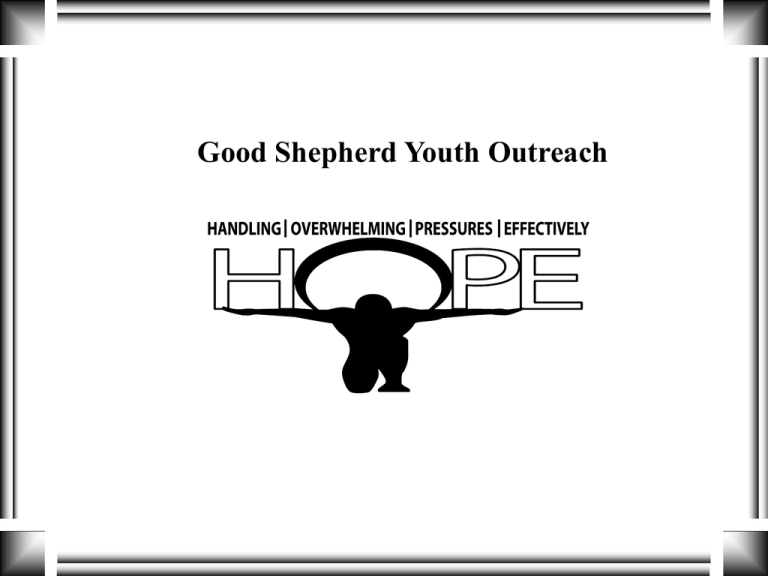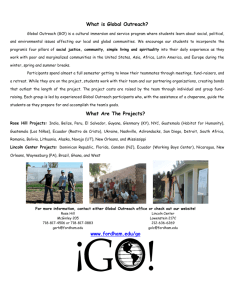National_Mentoring_F.. - National Mentoring Partnership
advertisement

Good Shepherd Youth Outreach Faith Based Mentoring Strategies for Effective Youth Outreach Development Goals & Objectives: • Gain tools to effectively advocate for disadvantaged minority youth and families in the community • Learn cost effective strategies to build a successful youth intervention model • Identify the primary faith-based youth outreach mishaps that lead to unsuccessful programs • Cultivate strategies to develop collaborative partnerships and expand the capacity of your youth outreach program • Understand the importance of cultural competence, community engagement, and racial equity in youth outreach program development • Identify the primary risk factors associated with disadvantaged youth • Develop effective tools and techniques to successfully engage with disadvantaged youth in urban communities The breeding ground for all disadvantaged youth begins with an excluded group, who feel victimized by poverty, or the establishment, or some other type of injustice, whether real or imagined. It is fed by an anti-establishment culture of drugs, crime, hate and racial separatism. ‘Consequential Faith’ Means… A creed to believe AND the ability to articulate their beliefs about a God who is both personal and powerful, A community to belong to including relationships with adults who speak with them about issues of life and faith, A “call” to live out, with their lives oriented by a divine vocation to serve others rather than the pursuit of self-satisfaction, and A hope to hold onto, seeing their lives as part of a “larger story that is going somewhere and is guided by God Kendra Casey Dean “Almost Christian’ Key Findings… Most U.S. teenagers have a positive view of religion but don’t give it much thought Most teenagers mirror their parents religious faith Teenagers lack a theological language with which to express their faith or interpret their experience of the world Many teenagers enact and espouse a religious outlook that is distinct from tradition of most world religions an outlook called Moralistic Therapeutic Deism From the Words of A Youth… “I guess I’m a Christian, but I’m one of those still trying to figure everything out. I believe there’s a higher power, but that’s about all I know for sure” (17 year old African-American Protestant girl) “Being a Christian means, um, don’t do many sins, read the bible, go to church, living Godly, that’s about it. It’s basically not committing sin, basically.” (16 year old African American conservative protestant girl) From the Words of A Youth… “My beliefs are so wishy-washy, like I’ll think something one minute, something else the next. I don’t know what is most important, cause I don’t really live by the bible.” (18 year old catholic girl) “If you do the right thing and don’t do anything bad, I mean nothing really bad, you know you’ll go to heaven. If you don’t then you’re screwed (laughs) that’s about it.” (15 year old white conservative boy) A Prophetic Warning… Despite strong levels of spiritual activity during the teen years, most twenty-somethings disengage from active participation in the Christian faith during their young adult years and often beyond that. Twenty-somethings 61% of today's young adults had been churched at one point during their teen years but they are now spiritually disengaged (i.e. not actively attending church, reading the bible, or praying).” What’s Working? How are we helping young people: Grow and be successful in all aspects of life? Deepen their faith and ability to talk about it? Establish relationships with healthy adult believers? Discern their gifts and call to engage in service to others? Be assured of their hope and worth in God, both now and for eternity? People in Systems… Risk Factor Categories COMMUNITY SCHOOL At-Risk Youth Defined: FAMILY Youth which are exposed to more than one risk factor which increase their vulnerability to juvenile delinquent behaviors PEERS Risk Factor Categories Defined COMMUNITY PEERS FAMILY • Access to Drugs/Guns • Physical Abuse • High Crime • • Low Income Lack of Support • Lack of Community Programs • Structure • Dysfunctional behaviors SCHOOL • Lack of Acceptance • Academic Challenges • Negative rebellious influence • Lack of Commitment • Lack of Motivation • Learning Disabilities • Competition • Peer Pressure The Fruits They Bear Violence & Conflict Behavior Problems Alcohol Low SelfEsteem Poor academic performance Gang Affiliated Sexually Active Drugs Cultural Competencies Cultural Self Awareness Cultural Competence Continuity CULTURAL COMPETENCIES Attitude Towards Cultural Difference CrossCultural Skills Knowledge of Diverse Cultural Practices Point To Remember Connecting with disadvantaged youth begins with cultural competence Cultural competence skills enhances your ability to connect-engageinteract with disadvantaged youth from diverse backgrounds Developing Cultural Competencies Listen Open Relate Select material, activities, examples that students can identify with Remove prejudice/ stereotype attitudes opinions that cause cultural barriers and prevent connection Let them speak, listen to them /get to know them, show you care. Listening is a critical tool in building any relationship Adjust Learn Adjust strategies to meet the needs of your youth Invest time to learn about the culture of students in your group Point To Remember Culture is a way of doing things for a specific group of people. Culture includes: art/music/literature/food/dress/rituals/language. The Individual Hate Fear Anger Miserable Hopeless Hurt Sad Alone Worthless Depressed Perceptions Perception is your personal view point of how you identify situations and circumstances based on specific influences and prior experiences. HOW DO I VIEW MYSELF? = HOW DO I VIEW OTHERS? Our Front Pack Heart 3 R’s Resentment Resistance Revenge Become Barriers Negative Reaction Put Up A Wall Want to Get Even Our Belief System Bias Negative Programmed Prideful No Love No Hope Process Structure How Perceptions Causes Barriers Something Deeper How We Get Stuck ‘In The Box’ Collusion ‘The Invitation’ Final Thoughts The Conclusion No Control Restrains No Power Outcome No Fulfillment Weak Person No Way Out Trapped No Results Satisfied Causes of Behavior Challenges EXTERNAL FACTORS INTERNAL FACTORS Family Structure Learning Disabilities Emotional Health Support System Mental Health Environment Economic Status Point To Remember Behavior challenges are a combination of internal & external factors. Keep this in mind when selecting a remediation strategy to address behavior challenges. Biology Impact of Trauma Persistent trauma can cause the brain to be underdeveloped or damaged. A damaged or undeveloped brain often causes a child to react differently to a stressful situation than a child without those constrictions. Therefore, a child who is more reflexive than reflective may have a biological reason for behaving the way they did which is beyond their control. This is an essential understanding for all individuals in order to modify their approach to the behavior. The Art of Learning and Teaching Views of Trauma When we see a youth with traumatic affect, we are seeing the tip of an iceberg that extends into family and community. The Art of Learning and Teaching Asking for Help Trusting Others The Barriers Changing Perceptions Forgiveness of the Past Expressing Emotions Parent Anger Parent Youth Wounds Relationship Parent (Love) (Support) Youth Where can we make a difference through our programs? Betterment to Development Assets Youth Bring to The Community Time Ideas & C reativity C onnection to Place D reams & D esires Peer G roup Relationships Family Relationships C redibility as Teachers Enthusiasm & Energy Potential Partners For Youth Associations Individuals Local Youth Public Institutions Businesses Basic Assumptions C ommunity Youth D evelopment Asset-Based C ommunity D evelopment ▪ gives us a positive view of every community Positive Youth D evelopment ▪ gives us a positive view of youth C ommunity Youth D evelopment ▪ gives us a positive view of what youth can do to shape the communities they live in The Ultimate End of Community Youth Development To engage youth in creating a healthy environment in which where all of community members can thrive. How Do We See Our Communities? Empty places filled with empty people the needs-based image The return of hope the assets-based image The key difference a focus on what is there, not what is not Asset Mapping D iscovering C ommunity C apacity Individuals ▪ people with gifts and capacities Associations ▪ people working together for good Institutions ▪ rich storehouses of accessible resources O utside help ▪ investment in capacity-building, not service expansion Neighborhood Map Neighborhood Asset Map Reading The Story of Community Space Structures Scraps of Life Signage Symbols Sounds & smells Signs of hope Social interactions A Theology of Youth Discipleship Affirming God’s intentions for youth, families, communities & ministry Affirming the nature & importance of disciple-making, and our commitment to it Building leadership on a foundation of authentic followership A Theology of Youth Discipleship Youth D iscipleship is a transformational process whereby youth become more like God.. Youth are equipped to do works of service The process involves instruction, modeling, participation, and application Helping Youth Become R.E.A.L. Responsible Accountability is the key underlying value Ethical Doing what’s right even when no one is watching Authentic Being your true ‘best self’ at all times Loving C aring for others unconditionally A Developmental Pathway An Asset-Building ‘Scorecard’ Is asset-building for our youth an explicit component of our mission, vision & values? D o our programs and activities actively promote asset- building for our youth? Are our volunteer mobilization strategies inclusive, strengthsbased & youth-friendly? D o we actively involve youth as partners in governance & leadership at all levels? D o we collaborate with other community-serving organizations in our neighborhood? Key Principles Youth Transformation requires… H olistic approaches versus narrowly-focused programs C ommunity ownership versus external Intervention Mutual transformation versus experts in charge Key Principles Youth Transformation requires… Long-term sustainability versus quick fixes creates _ Leverage Empowered young people versus youth as bystanders Asset-based view of community versus needsbased Transform Community Transform People Youth Development Youth & Community H.O.P.E. Transform Infrastructure Reconciliation & Rehabilitation Good Shepherd Youth Outreach OUR ORGANIZATION Educate Empower Equip ABOUT GOOD SHEPHERD YOUTH OUTREACH Our History Founded in 2008 by Louis Guiden, Jr., Good Shepherd Youth Outreach (GSYO) is a non-profit organization that employs prevention/intervention strategies to develop services/programs which educate and rehabilitate primarily minority at-risk youth in Western Washington communities. Our Mission We exist to educate, empower and equip promising, at-risk minority youth to transform their lives. Our Purpose GSYO's purpose is to bring life changing opportunities to promising, at-risk-youth across the country by providing an inspirational message of hope, building strong partnerships, supporting families and offering effective mentoring programs. “Greatness can be achieved when someone is given the resources and an opportunity to excel…” Louis Guiden, Jr. www.goodshepherdyouthoutreach.com Phone: 206.257.2252 ABOUT GOOD SHEPHERD YOUTH OUTREACH Our Vision for Success GSYO's vision is that our work will result in the positive advancement of minority youth, families, and community. Our Families Families that are stable, connected and supporting each other. Our Youth Youth who are healthy, holistic, engaged, economically productive and make positive contributions in the community. Our Community Communities that are safe, healthy and prosperous with a diverse workforce. www.goodshepherdyouthoutreach.com Phone: 206.257.2252 ABOUT GOOD SHEPHERD YOUTH OUTREACH Current Partners King County Superior Court REACH Tacoma Goodwill Center Federal Way Schools/Tacoma Public Schools Juvenile Rehabilitation Administration Our Group Mentoring Model Relationship Building Recovery & Rehabilitation Mutual Trust Personal Accountability Transparency Replacement Behaviors Cultural Awareness Transition & Advancement Self Value Goal Setting Coaching & Guidance Decision Making Problem Solving Sustainment & Continuity Resource Provision Skill Building www.goodshepherdyouthoutreach.com Phone: 206.257.2252 ABOUT GOOD SHEPHERD YOUTH OUTREACH The H.O.P.E. Program Overview The H.O.P.E. Program provides services and activities that focus on preventing criminal behavior and reinforcing pro-social behaviors. H.O.P.E. starts with education and empowerment, and builds on those foundations by providing youth with life skills and other necessary competencies all geared toward moving youth into becoming successful adults. The H.O.P.E. Program is completed over a 12 month period, with services that en-compass education, resource referral, family involvement, and community service. During the year, mentors meet with each youth 2-3 times a week, more often if there is a crisis. Each group being mentored consists of between 8-12 youth, who meet both as a group and individually though- out the course of the program. The H.O.P.E. group mentoring program emphasizes the importance of education, and provides guidance so that youth can get their high school diploma or GED, and advance to a 2 or 4 year college or trade or vocational school. www.goodshepherdyouthoutreach.com Phone: 206.257.2252 THE H.O.P.E. PROGRAM Specific Program Targets For Youth Participants Help youth learn to manage anger and conflict. Boost their self-esteem. Address mental health issues (i.e., depression). Move youth out of situations likely to involve them in delinquency, gangs, and substance abuse. Target Audience Pregnant Teens or Teens with children Minority youth between the ages of 1420 Foster Care Youth Youth in transition (preparing for high school or preparing for college) Juvenile Delinquent Youth Youth experiencing challenges from broken homes www.goodshepherdyouthoutreach.com Youth with educational achievement challenges Gang Affiliated Youth Phone: 206.257.2252 THE H.O.P.E. PROGRAM Program Approach: Meeting the Needs of Our Youth GSYO understands the importance of leveraging and combing multiple approaches to maintain the genuine interests and active engagement of youth participants. The H.O.P.E. group mentoring program uses a combination of career advancement teaching, entrepreneurship skill building, experimental learning, and recreation activities to educate and empower youth. Collectively, all sessions and activities are designed to blend core life skills, literacy, and other educational components they will encounter in their regular school work and life decisions. Career Advancement & Entrepreneurship Job Readiness & Opportunity Recognition Business Ownership Financial Literacy Leadership Development Academic Importance www.goodshepherdyouthoutreach.com Experimental Learning & Recreational Activities Team Building & Fair Competition Build Trust & Confidence Positive Exposure to Diverse Environments Healthy Relationship Building Effective Life Skills Phone: 206.257.2252 THE H.O.P.E. PROGRAM Expected Program Outcomes During the course of the 12-month group mentoring program, youth will have engaged in a variety of pro-social events, team building sessions, self esteem workshops, leadership development classes, relationship building activities, career advancement and job readiness training. As a result of participating in some or all of these sessions, it is expected they will have gained the following seven core competencies: Core Competencies of a Successful Program Exit Positive, pro-social behaviors that replace negative, addictive behaviors The ability to build trusting, healthy relationships The capacity to become a law-abiding, productive adult An aversion to returning to gang life www.goodshepherdyouthoutreach.com A sense of their own selfworth and empowerment An ability to identify and reach specific goals and the capacity to access the resources necessary to achieve those goals A sense of commitment and purpose for themselves Phone: 206.257.2252 THE THEH.O.P.E. H.O.P.E.PROGRAM PROGRAM Challenges Working with Juvenile or Gang Population The challenges are formidable, and require a measured, thoughtful, and individualized strategy. GSYO’s extensive work with this population has demonstrated the following five areas to be some of the most frequently encountered barriers experienced by the youth in our program: Frequent Encountered Barriers Distrust Few of the youth in this program have had any reason to trust anyone, certainly not adults, and definitely not adults associated with the System. Low Self-Esteem Most of the youth in the group mentoring program have a very low sense of their own selfworth, having been taught they have no value. Mental Health Issues Many of the youth mentored by H.O.P.E. have suffered severe trauma and even PTSD as a result of their exposure to violence, abuse, stress, and death. www.goodshepherdyouthoutreach.com Addictions Many of the youth in the program have drug and/or alcohol addictions that must be addressed before the youth can move forward. Criminal Background Many youth are deeply discouraged by the fact that they have a criminal record, and feel they have foregone any possibility of being gainfully employed as a result. Phone: 206.257.2252 The Successful Plan Identification Services Anger Management Problem Solving Life Skills Faith & Hope Job Skill Training Educational Assistance Job Finder Assistance Home Life Assessment Home Visits Individualized Plans PreAssessment Intake Outcomes Gang Activity Expulsion Employability Skills Job Placement Pro-Social Skills Decreased Violence Increased Attendance Increased Grades Decreased Office Referrals Intervention Results Unity in Community Stronger Families Model of Success Public Recognition Safer Communities Family Reconciliation Economic Productivity Restoration Youth Engagement Continuum INTERVENTION DEVELOPMENT Youth Services Approach Youth Development COLLECTIVEEMPOWERMENT Youth Leadership Community Enga gement SYSTEMIC CHANGE Youth Organizing From Bondage to Freedom What does it mean to be truly FREE? How are our youth in BONDAGE? We can not ignore the spiritual bondage of our youth From Bondage to Freedom We MUST NOT ignore Social and Physical Bondage of UrbanYouth Being FREE to be FULLY Human God showed us what it meant to be FULLY Divine and FULLY Human This is our vocation in God Question? If you were hungry, angry, lonely, tired, afraid, poor, failing or unhealthy, could you become disadvantaged?




